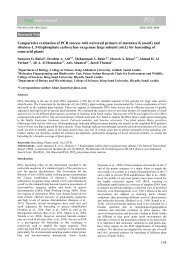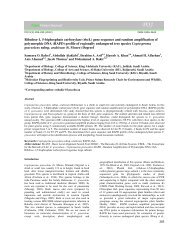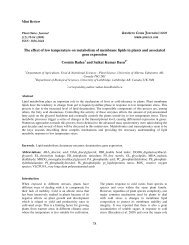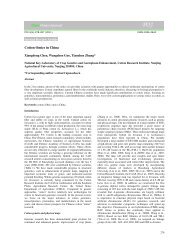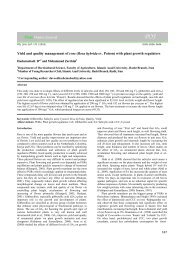Potential of Molecular Markers in Plant Biotechnology - ResearchGate
Potential of Molecular Markers in Plant Biotechnology - ResearchGate
Potential of Molecular Markers in Plant Biotechnology - ResearchGate
Create successful ePaper yourself
Turn your PDF publications into a flip-book with our unique Google optimized e-Paper software.
Review article<br />
environmentally <strong>in</strong>fluenced, which means that the<br />
same band<strong>in</strong>g pr<strong>of</strong>iles can be expected at all times for<br />
the same genotype.<br />
Applications: Allozymes have been applied <strong>in</strong> many<br />
population genetics studies, <strong>in</strong>clud<strong>in</strong>g measurements<br />
<strong>of</strong> out cross<strong>in</strong>g rates (Ersk<strong>in</strong>e & Muehlenbauer 1991),<br />
(sub) population structure and population divergence<br />
(Freville et al. 2001). Allozymes are particularly<br />
useful at the level <strong>of</strong> conspecific populations and<br />
closely related species, and are therefore useful to<br />
study diversity <strong>in</strong> crops and their relatives (Hamrick<br />
& Godt 1997). They have been used, <strong>of</strong>ten <strong>in</strong> concert<br />
with other markers, for f<strong>in</strong>gerpr<strong>in</strong>t<strong>in</strong>g purposes (Tao<br />
& Sugiura 1987, Maass & Ocampo 1995), and<br />
diversity studies (Lamboy et al. 1994, Ronn<strong>in</strong>g &<br />
Schnell 1994, Manjunatha et al. 2003), to study<br />
<strong>in</strong>terspecific relationships (Garv<strong>in</strong> & Weeden 1994),<br />
the mode <strong>of</strong> genetic <strong>in</strong>heritance (Warnke et al. 1998),<br />
and allelic frequencies <strong>in</strong> germplasm collections over<br />
serial <strong>in</strong>crease cycles <strong>in</strong> germplasm banks (Reedy et<br />
al. 1995), and to identify parents <strong>in</strong> hybrids (Parani et<br />
al. 1997).<br />
B. <strong>Molecular</strong> <strong>Markers</strong>: A molecular markers a DNA<br />
sequence that is readily detected and whose<br />
<strong>in</strong>heritance can be easily be monitored. The uses <strong>of</strong><br />
molecular markers are based on the naturally<br />
occurr<strong>in</strong>g DNA polymorphism, which forms basis for<br />
design<strong>in</strong>g strategies to exploit for applied purposes. A<br />
marker must to be polymorphic i.e. it must exit <strong>in</strong><br />
different forms so that chromosome carry<strong>in</strong>g the<br />
mutant genes can be dist<strong>in</strong>guished from the<br />
chromosomes with the normal gene by a marker it<br />
also carries. Genetic polymorphism is def<strong>in</strong>ed as the<br />
simultaneous occurrence <strong>of</strong> a trait <strong>in</strong> the same<br />
population <strong>of</strong> two discont<strong>in</strong>uous variants or<br />
genotypes. DNA markers seem to be the best<br />
candidates for efficient evaluation and selection <strong>of</strong><br />
plant material. Unlike prote<strong>in</strong> markers, DNA markers<br />
segregate as s<strong>in</strong>gle genes and they are not affected by<br />
the environment. DNA is easily extracted from plant<br />
materials and its analysis can be cost and labour<br />
effective. The first such DNA markers to be utilized<br />
were fragments produced by restriction digestion –the<br />
restriction fragment length polymorphism (RFLP)<br />
based genes marker. Consequently, several markers<br />
system has been developed.<br />
What is an ideal DNA marker<br />
An ideal molecular marker must have some desirable<br />
properties.<br />
1) Highly polymorphic nature: It must be<br />
polymorphic as it is polymorphism that is measured<br />
for genetic diversity studies.<br />
2) Codom<strong>in</strong>ant <strong>in</strong>heritance: determ<strong>in</strong>ation <strong>of</strong> homozygous<br />
and heterozygous states <strong>of</strong> diploid organisms.<br />
3) Frequent occurrence <strong>in</strong> genome: A marker should<br />
be evenly and frequently distributed throughout the<br />
genome.<br />
4) Selective neutral behaviours: The DNA sequences<br />
<strong>of</strong> any organism are neutral to environmental<br />
conditions or management practices.<br />
5) Easy access (availability): It should be easy, fast<br />
and cheap to detect.<br />
6) Easy and fast assay<br />
7) High reproducibility<br />
8) Easy exchange <strong>of</strong> data between laboratories.<br />
It is extremely difficult to f<strong>in</strong>d a molecular marker,<br />
which would meet all the above criteria. A wide<br />
range <strong>of</strong> molecular techniques is available that detects<br />
polymorphism at the DNA level. Depend<strong>in</strong>g on the<br />
type <strong>of</strong> study to be undertaken, a marker system can<br />
be identified that would fulfill at least a few <strong>of</strong> the<br />
above characteristics (Weis<strong>in</strong>g et al. 1995). Various<br />
types <strong>of</strong> molecular markers are utilized to evaluate<br />
DNA polymorphism and are generally classified as<br />
hybridization-based markers and polymerase cha<strong>in</strong><br />
reaction (PCR)-based markers. In the former, DNA<br />
pr<strong>of</strong>iles are visualized by hybridiz<strong>in</strong>g the restriction<br />
enzyme-digested DNA, to a labeled probe, which is a<br />
DNA fragment <strong>of</strong> known orig<strong>in</strong> or sequence. PCRbased<br />
markers <strong>in</strong>volve <strong>in</strong> vitro amplification <strong>of</strong><br />
particular DNA sequences or loci, with the help <strong>of</strong><br />
specifically or arbitrarily chosen oligonucleotide<br />
sequences (primers) and a thermos table DNA<br />
polymerase enzyme. The amplified fragments are<br />
separated electrophoretically and band<strong>in</strong>g patterns are<br />
detected by different methods such as sta<strong>in</strong><strong>in</strong>g and<br />
autoradiography. PCR is a versatile technique<br />
<strong>in</strong>vented dur<strong>in</strong>g the mid-1980s (Saiki et al. 1985).<br />
Ever s<strong>in</strong>ce thermos table DNA polymerase was<br />
<strong>in</strong>troduced <strong>in</strong> 1988 (Saiki et al. 1985), the use <strong>of</strong> PCR<br />
<strong>in</strong> research and cl<strong>in</strong>ical laboratories has <strong>in</strong>creased<br />
tremendously. The primer sequences are chosen to<br />
allow base-specific b<strong>in</strong>d<strong>in</strong>g to the template <strong>in</strong> reverse<br />
143



